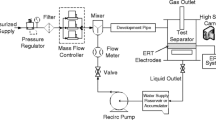Abstract
The separation of multiphase flow constituents in a microgravity environment is of considerable interest as the functionality of many spacecraft systems is dependent on the proper sequestration of interpenetrating gas and liquid phases. Cyclonic separators provide the desired gas-liquid separatory action by swirling the multiphase flow—causing the gas to accumulate along the axis of the vortex as the denser liquid is forced to the walls—thereby allowing segregated extraction of the respective phases. Passive cyclonic separators utilize only the inertia of the incoming flow to accomplish this task. In the current work, combined experimental, numerical, and phenomenological modeling analyses have been performed to quantitatively describe the steady and dynamic response of these separators. Specifically, the gas core behavior under steady conditions as well as under single-phase and multiphase injection step-changes have been examined experimentally and compared to computational fluid dynamics results. Also, a simple control-volume analysis of the cyclonic separator has been created and compared to these results. The results afford insight into the transient behavior of the device with respect to both the device and system-level conduct.















Similar content being viewed by others
References
Friesen, T., Takajira, H., Allegro, L., Yasuda, Y., Kawaji, M.: Numerical simulations of bubble motion in a vibrated cell under microgravity using level set and VOF algorithms. Ann. N. Y. Acad. Sci. 974, 288–305 (2002)
Hoyt, N., Kamotani, Y., Kadambi, J., McQuillen, J., Sankovic, J.: Computational Investigation of the NASA Cascade Cyclonic Separation Device. Proceedings of the AIAA 41st Aerospace Sciences Meeting and Exhibition AIAA-2008-0809 (2008)
Hoyt, N., Kang, M.F., Kharraz, A., Kadambi, J., Kamotani, Y.: Cyclonic two-phase flow separator experimentation and simulation for use in a microgravity environment. J. Phys. Conf. Ser. 012056, 327 (2011)
Liu, Y., Guohui, L., Kallio, S.: Hydrodynamic modeling of dense gas-particle turbulence flows under microgravity space environments. Microgravity Sci. Technol. 23(1), 1–11 (2011)
OpenFOAM User Guide v2.0.1: OpenCFD. Available from http://foam.sourceforge.net/docs/Guides-a4/UserGuide.pdf (2012)
Schlichting, H.: Boundary-Layer Theory. McGrawhill, New York (1979)
Schrage, D., Shoemaker, J., McQuillen, J.: Passive Two-Phase Fluid Separation. Proceedings of the 36th Aerospace Sciences Meeting and Exhibition (Reno, NV) (1998)
Acknowledgments
This work is being performed under NASA Grant No. NNX09AI31G with supervising project scientist John McQuillen of Glenn Research Center.
Author information
Authors and Affiliations
Corresponding author
Rights and permissions
About this article
Cite this article
Hoyt, N.C., Kang, MF., Lee, KL. et al. Study of Steady and Dynamic Behavior of Gas Core of Passive Cyclonic Separator for Space Applications. Microgravity Sci. Technol. 25, 187–200 (2013). https://doi.org/10.1007/s12217-013-9346-9
Received:
Accepted:
Published:
Issue Date:
DOI: https://doi.org/10.1007/s12217-013-9346-9




